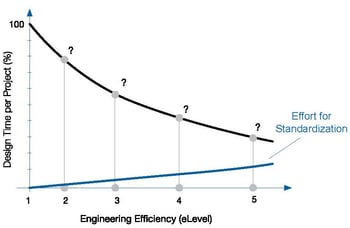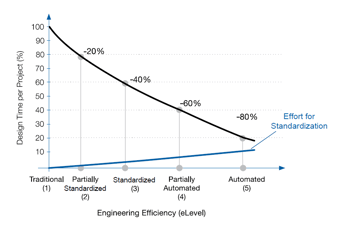Author
What would you do with 75% more time?
The world is talking about Industry 4.0, a complex revolution that is taking place as we speak. By marrying procedures and the intelligent networking of machines, companies are not only creating interconnected systems, but are also able to communicate, analyze and drive the development of smart processes. But what about the strategic digitization of design and control engineering for machines and plant systems? That’s a valid concern as a main challenge in both manufacturing and engineering is always implementing the customer’s individual requirements and requests, efficiently.
To answer that question let’s first look at “Engineering 4.0”, an eight-month study exclusively for EPLAN by the European 4.0 Transformation Center (E4TC) at RWTH Aachen University. Engineering 4.0 examined the efficiency potential and use of CAE software in electrical design of German machines engineering companies that manufacture mass-produced machines and special machines, engineering office/hardware planners and devices.
The E4TC researchers in Aachen first introduced a reference model for the engineering workflow and created an evaluation matrix with five levels of efficiency.

The Efficiency Level Matrix is accompanied by a Use Level Matrix. This describes and evaluates the use of CAE software as the basic prerequisite for “Engineering 4.0”. The generated Engineering Workflow Model comprises of the typical work steps for processing an order. The researchers focused on engineering, design, bills of materials, reports, control cabinet layout and devices and templates for the obvious reason: companies virtually have complete control in these areas to tap into potential time and cost savings through standardization or automation projects. “The dependencies on customers or partners in these process steps range from relatively low to non-existent.” Notes Dr. Thomas Gartzen E4TC Managing Director.
Each eLevel saves time.
To be able to evaluate the efficiency of each work step, the study scaled the workflow methodology into five stages – each corresponding to an efficiency level (eLevel) of engineering.

The study hypothesis is as follows: A higher degree of automation can reduce the method value, meaning the effort necessary for creating a schematic page. In turn, the effort for standardization increases with a higher degree of automation. Design time and effort for standardization depends on the engineering method.

Some of the findings included:
- Device-oriented work methods bring 25% time savings in the creation of schematics
- Using a circuit library for product functions resulted in 50% time savings
- Another 25% reduction can be achieved by introducing partial automation
- Standardization completely eliminated the time necessary for creating reports
Using the collected data, the researchers determined that companies can become about 20% more efficient in their overall processes as they move from eLevel to eLevel.

What is the optimal level of automation?
There are many factors that determine the extent to which automation increases efficiency as such; the variance of the engineering task, the engineering to order (ETO) percentage, the programming expertise, the engineering department’s level of experience, etc. While efficiency can’t be calculated directly, it can be compared and estimated using benchmarks. When all factors are considered it was found that partial automation resulted in the best ratio between effort and benefits for companies.
To see the full study design, participant metrics and market trend forecasts, request your copy of “Engineering 4.0” now.




Comments